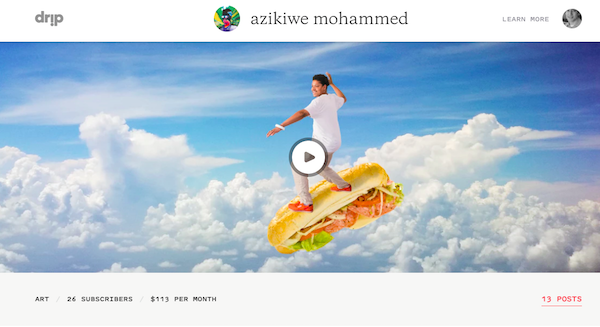Drip and Patreon are two subscription crowdfunding websites that you can use to raise funds for your work on a continual basis.
This means that rather than having to launch multiple Kickstarter campaigns, you’ll just be running one and collecting funding every single month from your subscribed backers.
I’ve already written extensively about Patreon in the past. If you haven’t already, you can check out some of the best practices for putting together a good page.
With this article, I’m going to go through some of the similarities and differences between these two sites that creators can use to monetize and finance their work.
Drip
At the time of writing, Drip is an invite-only service that’s owned by Kickstarter. You can use the website to get funding for your creative work through the ongoing support of your fans or subscribers.
All you have to do to begin a campaign is request an invite. Once you’re approved, you’ll upload a pitch video, reward tiers, and a description of what you’re offering with your project. You can find a sample layout below of Azikiwe Mohammed’s campaign.
What do fans get out of their financial support? Similar to Kickstarter, creators on Drip offer “rewards” in exchange for subscribing to their project. By becoming a subscriber, you’ll gain access to insider perks.
Below, I’ve shown an example of one of the rewards for Elizabeth Haidle’s Drip campaign.
At the $3 per month tier, she is offering access to Illustration/Comics + Fig.Drawing + work-in-progress notes.
There are two major benefits when you choose to go with Drip. First of all, the website is integrated with Kickstarter, meaning that “Kickstarter’s 13.7 million backers can use their existing login details and stored payment information to easily support creators on Drip.”
Next, for those creators who sign up, you don’t have to worry about being locked-in to Drip as a service. You’ll be able to “export your Drip data and content, and we’ll even help you securely transfer subscription and payments information to other subscription platforms.”
This makes it easy to try Drip, and if you don’t like it, use another subscription crowdfunding platform.
Fees: 5% fee on subscriptions + payment processing
Patreon
Patreon is another subscription service that has gained a ton of attention amongst YouTubers, creative types, and other online influencers. They also recently went under some heat when they changed their pricing, but they quickly changed it back.
According to the website, this platform boasts 1 million monthly active Patrons, $150 million of monthly earnings, and 50,000 monthly active creators. The average pledge per patron is about $12. In 2016, 35 creators earned more than $150k on the site.
For example, Kurzgesagt – In a Nutshell is one creator that makes science animation videos. He pulls in $36,179 per month from 10,000 patrons.
As with a traditional crowdfunding launch, all you need to do is upload a pitch video, customize reward tiers, and create the campaign text to share the value of becoming a subscriber.
Rewards could include access to exclusive videos, episodes, special recognition and more. Patrons give on a per month or per creation basis.
Pricing: 5% + payment processing fee.
Which is Better For You?
At the time of writing, Patreon definitely has more of a fleshed out website than Drip. After all, Drip is still in the beta invite-only stage.
It’s difficult to compare these two websites at this stage because Patreon is so far ahead of Drip. Patreon is clearly the large and entrenched competitor in this arena.
When the news broke about Patreon changing up their pricing, a lot of creators responded with outrage, leading them to back peddle on their announcement. They went on to say that in the future, they’ll be more aware of the community when making major changes.
It looks like Kickstarter is putting “creator independence” at the forefront of their platform. They are allowing you to easily export all of your data if you want and change platforms.
If Kickstarter “gets their Drip platform right,” then I do think they could be a serious contender. They have a ton of customer and backer data.
However, until they do that, it’s going to make the most sense to either go with Patreon or host the campaign on your own website. There just aren’t enough significant Drip success stories.
Actually, I discovered a ton of tricks that can help you earn recurring income from Patreon using subscription crowdfunding. This is dependable, repeat income to fuel your craft. You can really turn your passion into profit. You can learn more about the Patreon tricks I’ve discovered here.









